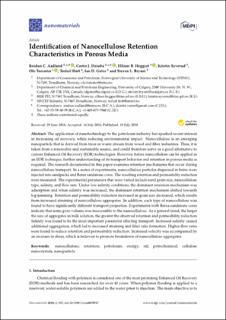| dc.contributor.author | Aadland, Reidun Cecilie Grønfur | |
| dc.contributor.author | Dziuba, Carter Jordan | |
| dc.contributor.author | Heggset, Ellinor Bævre | |
| dc.contributor.author | Syverud, Kristin | |
| dc.contributor.author | Torsæter, Ole | |
| dc.contributor.author | Holt, Torleif | |
| dc.contributor.author | Gates, Ian D. | |
| dc.contributor.author | Bryant, Steven | |
| dc.date.accessioned | 2020-12-30T11:07:05Z | |
| dc.date.available | 2020-12-30T11:07:05Z | |
| dc.date.created | 2018-08-09T15:19:03Z | |
| dc.date.issued | 2018 | |
| dc.identifier.citation | Nanomaterials. 2018, 8 (7), . | en_US |
| dc.identifier.issn | 2079-4991 | |
| dc.identifier.uri | https://hdl.handle.net/11250/2721114 | |
| dc.description.abstract | The application of nanotechnology to the petroleum industry has sparked recent interest in increasing oil recovery, while reducing environmental impact. Nanocellulose is an emerging nanoparticle that is derived from trees or waste stream from wood and fiber industries. Thus, it is taken from a renewable and sustainable source, and could therefore serve as a good alternative to current Enhanced Oil Recovery (EOR) technologies. However, before nanocellulose can be applied as an EOR technique, further understanding of its transport behavior and retention in porous media is required. The research documented in this paper examines retention mechanisms that occur during nanocellulose transport. In a series of experiments, nanocellulose particles dispersed in brine were injected into sandpacks and Berea sandstone cores. The resulting retention and permeability reduction were measured. The experimental parameters that were varied include sand grain size, nanocellulose type, salinity, and flow rate. Under low salinity conditions, the dominant retention mechanism was adsorption and when salinity was increased, the dominant retention mechanism shifted towards log-jamming. Retention and permeability reduction increased as grain size decreased, which results from increased straining of nanocellulose aggregates. In addition, each type of nanocellulose was found to have significantly different transport properties. Experiments with Berea sandstone cores indicate that some pore volume was inaccessible to the nanocellulose. As a general trend, the larger the size of aggregates in bulk solution, the greater the observed retention and permeability reduction. Salinity was found to be the most important parameter affecting transport. Increased salinity caused additional aggregation, which led to increased straining and filter cake formation. Higher flow rates were found to reduce retention and permeability reduction. Increased velocity was accompanied by an increase in shear, which is believed to promote breakdown of nanocellulose aggregates. | en_US |
| dc.language.iso | eng | en_US |
| dc.publisher | MDPI | en_US |
| dc.rights | Navngivelse 4.0 Internasjonal | * |
| dc.rights.uri | http://creativecommons.org/licenses/by/4.0/deed.no | * |
| dc.subject | nanoparticle | en_US |
| dc.subject | cellulose nanocrystals | en_US |
| dc.subject | petrochemical | en_US |
| dc.subject | oil | en_US |
| dc.subject | energy | en_US |
| dc.subject | petroleum | en_US |
| dc.subject | retention | en_US |
| dc.subject | nanocellulose | en_US |
| dc.title | Identification of Nanocellulose Retention Characteristics in Porous Media | en_US |
| dc.type | Peer reviewed | en_US |
| dc.type | Journal article | en_US |
| dc.description.version | publishedVersion | en_US |
| dc.rights.holder | © 2018 by the authors. Licensee MDPI, Basel, Switzerland. This article is an open access article distributed under the terms and conditions of the Creative Commons Attribution (CC BY) license (http://creativecommons.org/licenses/by/4.0/). | en_US |
| dc.source.pagenumber | 22 | en_US |
| dc.source.volume | 8 | en_US |
| dc.source.journal | Nanomaterials | en_US |
| dc.source.issue | 7 | en_US |
| dc.identifier.doi | 10.3390/nano8070547 | |
| dc.identifier.cristin | 1600809 | |
| dc.relation.project | Norges teknisk-naturvitenskapelige universitet: 262644 | en_US |
| dc.source.articlenumber | 547 | en_US |
| cristin.unitcode | 7401,80,7,0 | |
| cristin.unitname | Petroleum | |
| cristin.ispublished | true | |
| cristin.fulltext | original | |
| cristin.qualitycode | 1 | |

